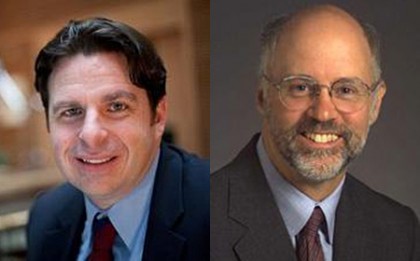During Sunday's heated presidential debate, an audience member raised the issue of health care, asking Hillary Clinton and Donald Trump about their plans to bring down costs and to make coverage better.
Both of the candidates' responses included references to a "single-payer plan." What does that mean, and could it work in the U.S.? For insight, we turned to experts from Johns Hopkins University's Bloomberg School of Public Health.
In a segment of WYPR's On the Record on Monday morning, Bradley Herring, an associate professor in the Department of Health Policy and Management at the Bloomberg School, explained what a single-payer system is and how it works.

Image caption: Bradley Herring (left) and Gerard Anderson
"The simplest way to think about a single-payer system is one in which the government is the single payer for all health care services for all citizens," Herring said.
Countries around the world have successfully adopted single-payer health systems. An obvious example—and the one Trump pointed to in the debate—is Canada.
"People pay taxes to the Canadian government, and then the Canadian government in turn sends money to the provinces, and the provinces pay the hospitals and pay for pharmaceuticals," Herring said. "But essentially the government is paying as the single insurer for everyone."
Gerard Anderson, also a professor in the Department of Health Policy and Management at the Bloomberg School, said a single-payer system would be "essentially the Medicare program expanded to cover everyone."
A single-payer system has certain potential advantages, Herring said. The operating costs of a government insurance plan would likely be significantly less than those of private insurance, especially because a government program would not spend as much on marketing, administration of claims, and medical underwriting—things private insurers must do in order to make a profit. Additionally, the government can negotiate with health care providers for lower costs.
"Currently, everyone gets their own deal—large insurers get reasonably good deals, the Medicare and Medicaid programs typically get even better deals," said Anderson, whose recent research focuses on how hospitals mark up prices for certain procedures, sometimes as much as 280 percent, in order to increase revenue. "People who are uninsured get the worst deal. And people who don't go into the network—their insurance doesn't work with that specific provider—also get the worst deal. A single-payer system would give everyone exactly the same deal."
The cost of health care is a common complaint about the current set-up. According to World Health Organization data, in 2014, the U.S. spent more on health care—17.1% of it gross domestic product—than any other nation in the world. The health exchanges set up under the Affordable Care Act were supposed to create competition and bring down costs, but results have been mixed.
"[The issue is coming up in the debates] because the health exchanges are falling apart," Anderson said. "The private insurance companies are not willing to accept risk. As a result, they are dropping out of the insurance exchanges, leaving one or two insurers in the market in many places. What that means is that there's no competition to drive down prices."
A move towards a single-payer system could help curtail costs, but the idea isn't without its critics. Among the arguments against a single-payer system: fewer choices for consumers, lower pay for doctors, lower profits for hospitals, and higher taxes as the responsibility for providing care shifts from employers to the government.
Perhaps the most significant question is one of feasibility: Given that the U.S. has an established, employer-based health insurance model, how difficult would it be to shift to a single-payer model?
For this reason, Anderson said, the most likely alternative to the current system is what he called a public option, in which consumers can choose to purchase either private insurance or coverage provided by a government-run health care program (such as Medicare).
"A public insurance option essentially allows people to purchase into Medicare," he said. "That is just sort of a beginning of moving into a single payer. It's probably going to be a less-costly alternative to private insurance, and it's going to be quite attractive to some people and attract more and more people into the program, making it harder for private insurance to compete."
Posted in Health, Voices+Opinion, Politics+Society
Tagged health care, health care spending, health policy, election 2016








